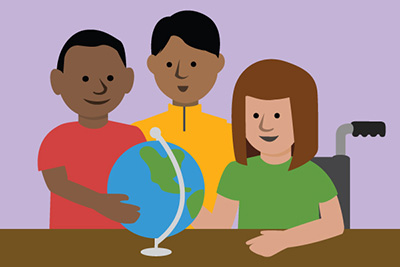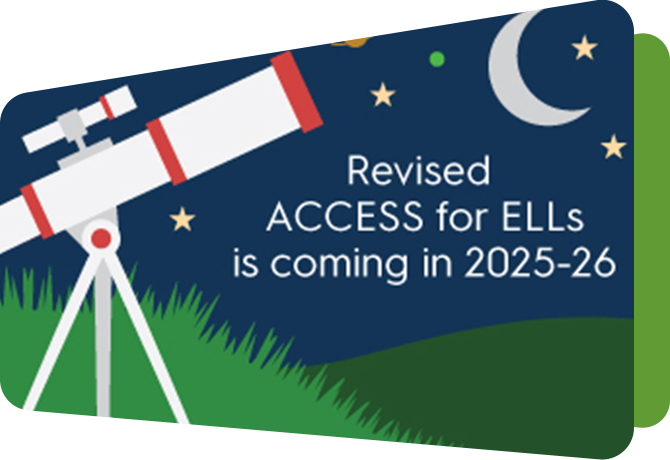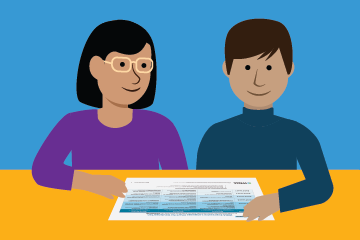Engaging multilingual learners in social studies classrooms

By Lauren Bartholomae
Social studies teaching and learning provide unique opportunities to foster connections between our multilingual students’ identities as global citizens, their academic learning and the roles they play each day across social communities.
As educators working with multilingual learners (MLs) in social studies classrooms, these opportunities bring a responsibility to recognize and highlight real-world connections to our curriculum, standards and classroom materials. Inquiry, storytelling and multimodal resources can build bridges between language, culture and content learning, and encourage authentic engagement of our MLs during social studies delivery and instruction each day.
Inquiry in social studies
An inquiry-based classroom approach uses investigation as a technique to unpack content themes, discuss theories and ideas and better understand social phenomena. Here are five approaches for inclusive application of inquiry during social studies teaching and learning.
- Question-driven exploration occurs when educators craft intentional questions aimed at developing the language necessary to dissect social studies concepts and engage in rich dialogue surrounding those concepts.
- Interactive meaning-making takes place when students engage in interactive and collaborative activities that relate to the compelling question and topic at hand.
- Fostering community connections encourages learners to design initiatives, create action plans and propose solutions to address challenges facing their communities.
- Including diverse sources that represent multiple perspectives involves providing artifacts, presenting images, documentaries and films as well as welcoming guest speakers.
- Connected opportunities to develop language requires analyzing classroom and curricula materials to identify the most prominent Key Language Use(s) and explicitly highlighting the Language for Social Studies outlined in the WIDA English Language Development Standards Framework, 2020 Edition, during lesson instruction.
The National Council for the Social Studies has more information on developing questions and planning inquiries through the College, Career, and Civil Life (C3) Framework for Social Studies State Standards.
Storytelling in social studies
Whether through narrative texts, images and video, historical letters or personal oration, the listening to and sharing of stories provides a meaningful way for learners to position themselves within a socio-cultural context. In classrooms, storytelling can be resourced as an academic tool to facilitate the learning of complex concepts by evoking emotions and encouraging discussion and critical thinking of a historical or cultural event.
For MLs, the presentation of diverse and global narratives creates opportunities to connect their cultural and linguistic identities to the lived experiences of others and derive deeper meaning across content standards. The social studies classroom provides a uniquely relevant platform to welcome narratives from our MLs, community members and voices from the past.
The impact of including stories within our social studies lesson cannot be understated. Studies on storytelling and the brain have shown a connective power that forms between a speaker or writer sharing their lived experience and their listener or reader. This emotional and cognitive response has also been found to lead to benefits on long-term memory, which positively influences student learning.
To learn more about this phenomenon, check out the Ted Talk, This is your brain on communication, by Princeton University neuroscientist Uri Hasson.
Multimodal resources and language development in social studies
As educators, you are keenly aware of how the evolution of technology has transformed the K-12 learning space and increased options for lesson interactivity over time. Leveraging this effectively, you can curate rich and accessible educational experiences and assessments of learning in your social studies classrooms. Below are a few examples of multimodal resources that can simultaneously enhance academic learning and support language development for our multilingual students.
- Virtual field trips offer the chance for students to visit museums or significant sites around the world across time and space. Through augmented reality, they can explore different geographical locales, listen to audio recordings in various languages and interact with enhanced and gamified exhibits across cultural and historical topics.
- Online databases such as the Library of Congress and National Archives provide free and inclusive access to a wide variety of authentic primary and secondary artifacts. Materials with the potential to connect to a spectrum of social studies standards can also be discovered, with representation across an array of languages, cultures, histories and modalities of presentation.
Want to learn more?
Check out WIDA’s self-paced workshop, Teaching Multilingual Learners Social Studies Through Multiple Perspectives! This course provides a deeper dive into literacy across multimodal text types, the integration of content and language learning and increased accessibility of materials using technology, inquiry and translanguaging practices.
*Note: Workshops available may vary by state.
About the Author
Lauren Bartholomae is a professional learning curriculum specialist in WIDA's Educator Learning, Research and Practice team. In this role, she engages in the research, development and facilitation of WIDA's professional learning with educators of multilingual learners across the consortium.





